 Photo from stephenhardingbooks.com/otherbooks.html
Photo from stephenhardingbooks.com/otherbooks.html Tammi
 Photo from stephenhardingbooks.com/otherbooks.html Photo from stephenhardingbooks.com/otherbooks.html In July this year, Da Capo Press will release The Last to Die, the latest book by Stephen Harding. In the meantme he is still doing promotion and interviews about The Last Battle, released in May of 2013. Recently he was interviewed by the BBC and sent me the link to share. Enjoy reading the article, and watching the video that goes with it. http://www.bbc.com/news/world-europe-32622651 Tammi 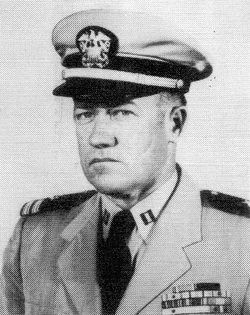 The nephew of Grady Lee Nelson, Jr., Mike Pauling contacted me back in January with information about his uncle. Mike found the web site and contacted me, and as I’ve done before I decided Grady needed a blog post so others could learn about him. Let me introduce you to Grady Lee Nelson of Coleman, Texas. Grady was born January 23rd, 1922. He enlisted in the Navy in May 1941. Prior to surviving the sinking of STRONG and going on to have an illustrious 30 year Naval career, Grady was on board the USS ARIZONA BB-39 in Pearl Harbor on December 7th, 1941. He was topside and had the responsibility of setting up chairs and preparing for a church service on that Sunday morning. Grady was not the only Nelson on board. He lost four relatives, an uncle and 3 cousins that day. Family members on board ARIZONA with Grady were Harl Coplin Nelson, S1C from Arkansas; Henry Clarence Nelson, BM1c from Minnesota; Lawrence Adolphus Nelson, CTCP from California; Richard Eugene Nelson, F3c from North Dakota. Grady survived because he was able to dive off the side as the ship sank. The commander of the ARIZONA was Captain Isaac Kidd who died during the attack. The USS KIDD DD-661, the Fletcher-class destroyer currently docked in Baton Rouge, Louisiana as a museum ship is named for Captain Kidd. Grady entered service with the USS STRONG DD-467 as a plank owner in May of 1942 with the rank of GM2c, a gunner’s mate. After the ship was torpedoed, Grady was one of the men rescued by the USS CHEVALIER DD-451, and lucky to be on the list of unwounded sailors. Though unwounded, Grady never spoke of his experience on STRONG to any family members and no known accounts of his story exist. I’ve found this is not unusual, and since he had already been through the ordeal at Pearl Harbor, it’s no wonder he kept his thoughts and emotions to himself. Being a plankowner, Grady and others like him had more of a personal and emotional investment in the ship than most. These events didn’t keep him from returning to the sea. After STRONG, he was assigned to another new destroyer, the USS ALBERT W. GRANT DD-649. GRANT was attacked by the Japanese in October 1944 during the first invasion of the Philippines toward the end of the war. She took 22 hits and was severely damaged. Casualties included 38 men killed and 104 wounded, but she was able to stay afloat. GRANT underwent repair and Grady was with her until February 1945, when he left to go stateside from Mare Island, California. After serving as gunner’s mate on other ships, he was tasked to teach small arms at the Naval Reserve Training Center in Boston, Massachusetts. He completed several courses in Navy school including Gunner’s Mate (to train others) and Electric Hydraulic School, 8”/55 Caliber Rapid Fire Turret training; 5”/54 Caliber gun training; Electrical, Electronics & Hydraulic School; ASROC Launcher and Instructor and Leadership School. He received a commission from Chief Gunner’s Mate to LT. Junior Grade in May 1961. After training at Limited Duty Officers School in Newport, Rhode Island (not part of the Naval War College located close by), was assigned to the staff of the Officers Candidate School as weapons instructor. In July 1963 he was assigned to USS BOSTON CAG-1 (Baltimore class heavy cruiser) as Missile Ordnance Gunner performing Weapons training, and was there until September 1965. Later, he was assigned to Fleet Training Center in Newport, Rhode Island as Weapons Training Officer. He retired as a much decorated officer after a long and distinguished career in the Navy. Grady died October 20th, 1993. In December of 1993, Grady was laid to rest in the wreck of the USS ARIZONA at Pearl Harbor with his uncle, cousins and other shipmates. If you would like to read the entire article on the memorial service, here is the link: http://chaplaincorps.navylive.dodlive.mil/2013/12/31/interments-for-pearl-harbor-veterans-and-burials-at-sea-a-sacred-privilege-and-naval-tradition/ On a couple of personal notes, Mike tells me Grady is responsible for him being here. While in training, Grady introduced one of his promising students to his daughter Ellen Nelson. They married and started a family, resulting in Mike. Thanks Mike, for sharing. In addition, Mike wanted me to know that in general Grady never held a grudge for the Japanese people. Over the years persons of Japanese descent married into the Nelson family. One of these men in particular was with his family in an internment camp in California during WW2. This camp, Manzanar National Historic Site is now a park and the gentleman is the director of the park. Thank you Mike and Ellen for providing me with the biography and other information on Grady. I appreciate being able to share these men with others and to learn about them myself. See the article below for more on his experiences at Pearl Harbor. Tammi Amazon.com and other sources I'm sure are taking pre-orders for the release of The Last To Die, the latest book by Stephen Harding to be released in July of 2015. I thought I'd post a link for you to follow if you are interested.
https://www.goodreads.com/book/show/22928886-last-to-die The story of Anthony Marchione, the last man to die in the days following the accords with Japan is a complicated and worthy story, another wonderfully told tale by Harding. This book will tide us over until the summer of 2016 when he releases his book about STRONG and Hugh Barr Miller, Jr.'s story of survival and rescue. I hope you take advantage of the link and enjoy the story. He will be doing book tours later this year and I will post his itinerary soon as it's available. I'm sure if he appears somewhere near you, you would like to have the opportunity to meet him. Tammi 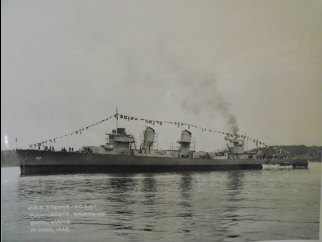 I’ve been inspired, again. Over the past few years I’ve found numerous things to inspire decisions I’ve made regarding this project. As I’ve acted on these decisions, I’ve found more success than failure, so it keeps me wanting to see what happens if I keep it up. For instance, at one point a few years ago I decided to seek an explorer who might be interested in helping me locate, document and film the wreck of STRONG. My first effort died in the water, so to speak. I didn’t give up and eventually met David Mearns of Blue Water Recoveries, LTD. If we are ever to kick this goal off my bucket list, David is the one who will get us there. Much remains to be done and nothing is certain, but I feel we are on the right track. Next, I thought it might be cool to start a web site to get the word out about the project and hopefully pull more people into the project. That has proved to be a true bounty, as over the past 2.5 years it’s been live I’ve located many more family members of STRONG men. Many of you have found me on your own and I couldn’t be happier. Then, I always thought the STRONG story deserved a book, a comprehensive well written book that told her story and the story of her men. Again, good fortune smiled on me the day I got the first email from Stephen Harding back in 2013. That book is in progress and due to be released in the middle of 2016. So far, I’m batting 1000. That gives me hope for my next set of bucket list goals, and those revolve around locating and documenting the ship. After watching the live stream (and then re-watching it) by Paul Allen and his research team from the wreck site of the IJN MUSASHI in the Sibuyan Sea of the Philippines (see link to project on previous blog), it triggered a lot of pistons in my brain. In the beginning, aside from a way to honor my great-uncle Billy and his shipmates I had thoughts of using the STRONG expedition should it come to be, as an educational and informational tool. Billy was a teacher prior to joining the Naval Reserve, and I believe he would be totally on board with something such as this. Over 500,000 people from around the world watched the live stream broadcast. That was a one-time deal as far as we know. No one but Mr. Allen has done this before. So what if you had a game plan for an expedition, from start to finish, documenting the steps along the way, something that could be accessed at any time by thousands of people? My idea for following an expedition on film is to do this in short vignettes, maybe no more than 10 minutes each that would describe the events leading up to the discovery, cover the discovery and then the aftermath. In these shorts we could discuss the history of the ship and even focus on some individual stories of the men. There would be primers on the equipment (ROV’s, AUV’s) used to locate the site, such as was seen for the MUSASHI. We could have someone discuss the history of the Solomon Islands during WW2 and the part the islanders played in helping the allies gain control. In addition there could be lessons on weather patterns, geology and volcanism, ocean currents, local wildlife and ecology – so many topics could be covered. These films could be posted on a web site dedicated to school children from kindergarten to high school. I’d especially like to have a focus toward high school kids working to decide on a career path, some things to consider when choosing a major for college. How many different job types are involved in the exploration industry? There are meteorologists, biologists, archaeologists, engineers, historians, marine scientists, mechanics- just a few examples of the many different vocations involved in this type of industry. In the past I have worked with kids of all ages on many levels. I miss that. This would be the perfect vehicle for pulling in kids, teachers and parents. The key is education and information. Do it in a manner that is entertaining and engaging and offer it to the world. I believe this is one way to help foster concern for these resources and to build respect for the sites that remain to be discovered. Kids dig deep sea exploration, and I for one can never get enough of watching anything on this topic that comes up on NatGeo, Discovery, History Channel or whatever. The kid in me is never satisfied. Let’s feed this information to our children in a way that keeps them seeking and searching for more. Let’s show them the world under the sea, the exploration of this world as they have never seen it. I’d love it to be interactive, where questions could be submitted and responses posted. This way they would know they are heard and their thoughts are important. It would be awesome to have the resources to pull this off. Bucket list has been updated, and the universe has been notified. I’ve been inspired. -Tammi At the end of February, Paul G. Allen of Microsoft fame located the wreck of the IJN MUSASHI, one of two Yamato class ships built by the Japanese for fighting in WW2. On the evening of March 12th, they ran a live stream feed from the expedition site in the Sibuyan Sea in the Philippines from his ship the MY OCTOPUS. For those who did not get to see the live stream, here is the link to the archived film: http://www.paulallen.com/galleries/musashi-expedition
It's a little over two hours and extremely interesting viewing. Not only do you see the ROV move over the wreck site as it's narrated by Rob Kraft and David Mearns of Blue Water Recoveries, LTD, but they teach us a bit about the equipment used, show us the bridge of the ship where the instruments do their job, and we meet some of the crew. All in all, some very interesting stuff to see. Watch and enjoy! Tammi 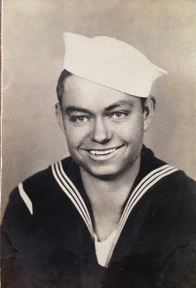 Benjamin Roy McElduff, S1c Benjamin Roy McElduff, S1c Over the past 2.5 years since I started the web site for the USS STRONG DD 467 project, I have been constantly amazed at the response from family members of sailors who served on board the ship. I don't know if it's fate, providence or what – but all of a sudden so many people are deciding to research the history of their STRONG man. Some tell me it's because their father/grandfather/uncle is still alive and has finally decided to share their story, so they go seeking information. With others, they lost their man years ago and the need to learn more has just become important to them. I currently have about 60 family members and numerous other friends on board and the list keeps growing. Most recently I was contacted by the relatives of sailors Grady Lee Nelson and Benjamin Roy McElduff. I plan to do a short story on Grady in the near future, but for the purposes of this blog let's talk about Roy. I got a message on Facebook from Roy’s niece recently telling me about him. He was born in Great Falls, South Carolina on September 8, 1921 to Ben and Rosa Stewart McElduff. Roy’s rank was S1C (signalman 1st class) on board STRONG and unfortunately one of the men who did not make it home. After talking with her, I learned that Roy's sister and her mother is 86 years old and lives with them. They were stuck without power in one of the recent snow and ice storms, and started doing some reminiscing about the past. Her Mom was 14 years old when they got the news that Roy was lost. Just as my Uncle Billy's sisters never stopped mourning his loss, it’s the same for her Mom. What makes this all the more poignant, is that Roy's life was saved as the ship was sinking by Lt. Hugh Barr Miller, Jr., only to have him go missing without a trace shortly after. If you've read the October 2013 blog about Stephen Harding and the book that is currently underway (scheduled for release sometime in 2016), then you know his focus in the book is the survival story of Lt. Miller. The USS CHEVALIER had to ram STRONG in order to rescue the survivors. As she was pulling away, one of the lines used to secure her to STRONG snapped and ended up lashed back against the side of STRONG, trapping Roy and Eddie Deering. On his way down into the water, Miller found the two men and struggled to cut them loose before STRONG went under. He was able to sever the line just as the ship sank beneath them. Miller, Roy, Deering and several others made it to a float net, and eventually to Arundel Island. On July 11th, four of the men set off to try and locate help, and Roy was one of the four. Two of the four men, Robert Butler and Sigmund McGee are known to have survived and made it back home. There's an extraordinary story here about the adventures of these two as they sought rescue, and I will cover this story in a future blog. It's unclear what happened to Roy and the other man. Eddie Deering died of his injuries on July 13th. Just from speaking with Billy’s sister Stella in the years before she died, I got a sense of the emotional trauma that families suffer when they just don’t know what happened. It might be different if you have a body that comes home to give a proper burial, but when there is no trace of your loved one I can see how a family is left in a state of perpetually wondering about their fate. I don’t know if following through with this project to its end will help to answer any of these questions, but I believe for my family it will provide a sense of closure. I can only hope it helps others to find closure as well. To the McElduff family, thanks for telling me about Roy. I welcome any other information you have to share in the future. -Tammi I'm finally able to post this obituary for Dr. Henry and Page Laughlin who passed within 24 hours of one another. I had a little personal setback last week (broke my ankle, required surgery), or it would have been posted on time. As it is, he was a remarkable man and his memory should be shared with the other STRONG families. Let me know if you'd like to contact the Laughlin family directly to express condolences.
Thank you Connie, and the rest of the Laughlin family for sharing: Hank & Page Laughlin Hank Laughlin died peacefully at age 98 on January 29, 2015, and Page Laughlin, his wife of 73 years, died the next day. They met in Stone harbor, NJ, where Hank was a life guard and while he was a medical student. Page was spending her vacation at her parents’ summer home and was a teenager studying at the Philadelphia College of Art. After graduating from Temple Medical School, Hank became a ship’s doctor aboard the USS Strong in the Pacific Theater during WW II, while Page remained in Oakland, CA, and raised Connie, John and Robert, their first three children. After the war ended, they moved to Montgomery County, MD, where Hank practiced psychiatry and Page took care of their five children, who now included Barbara and Deborah. Hank and Page moved to Frederick County in 1962. Their lives and accomplishments were extraordinary. Hank was a founding member of several honorary medical organizations, authored four medical textbooks, and is the only physician to be the president of both the Montgomery County and Frederick County Medical Societies. He was an excellent marksman, competing in the Lander, WY, one-shot antelope hunt for more than 20 years. His stamp collection numbered more than 700 volumes. Hank was president of the Maryland Chapter of the Sons of the American Revolution and was an active member of the Rotary Club of Frederick and the morning Frederick Coffee Club. Page was an avid genealogist and an accomplished seamstress and machine knitter. She was a member of MENSA, the DAR, the Daughters of Founders and Patriots and the Mayflower Society. Unlike Hank, Page loved new technology. Hank and Page shared a strong belief in the value of education and were supporters of Hood College, Mount St. Mary’s University and Frederick Community College, as well as their alma maters. Hank and Page are survived by five children: Connie Kuhn and husband Cliff of Louisville, John Laughlin and wife Diane of Frederick, Robert Laughlin and wife Abby of Frederick, Barbara Galant and husband Luke of Frederick, and Deborah Moss and husband Lee of Salt Lake City. They were fortunate to have eighteen grandchildren and twenty great grandchildren. A Memorial Service celebrating their lives will be held in the spring. In lieu of flowers, the family suggests that a gift in their name may be made to Ursinus College, Collegeville, PA. -Tammi Every now and again I get an email from one of you who have made a wonderful discovery. Sometimes you’re digging in a closet and find an old box or you visit a storage unit and end up locating something you’d forgotten your family member even had. Such a discovery was shared with me recently by the family of Dr. Henry Laughlin, the first medical officer on board STRONG who exited the ship the first of May, 1943. The sailors were not supposed to have their own cameras or to take photos or video. The military hired professional journalists (such as Duncan Norton-Taylor or Allan Jackson from previous blogs) who were approved to take photographs or video for recording the actions of various branches during war time. But, there were a few folks such as Dr. Laughlin who managed to fudge the rules. The second doctor on board, Dr. Albert Horne even brought a video camera and taped activities on board the ship. These however, are forever entombed with the ship in the bottom of the Kula Gulf. I’m happy to have the photos that made it off the ship. This means there are some interesting and first time ever photographs of their actions and whereabouts to share. Of these photos, there are a few I have been able to corroborate with the war diaries and verify the actual location of the ship and some of the action occurring when the photos were taken.
The photos in the gallery below are of Dr. Laughlin himself, a group of medical professionals together at Treasure Island in June of 1945 just prior to the end of the war (a tropical medical program off the coast of California), STRONG on the way to Africa on the shakedown cruise in the fall of 1942, a destroyer in the distance at Espiritu Santos March of 1943 (possibly STRONG, hard to read the hull numbers) and a refueling event in March of 1943 in the Coral Sea. Of the photos, two were easy to investigate. The Coral Sea refueling actually did take place on March 17th, 1943 as STRONG was engaged in actions with Task Force 18.6 and DESRON 21. The refueling ship was the USS KANKAKEE. What I love about this shot is Captain Wellings on the left foreground and the crew of the KANKAKEE can be seen on the deck hard at work. They refueled between 12:00 and 16:00 hours: “17 March 1943: Steaming as before. 1315 Commenced maneuvering at various courses and speeds to make approach for fueling. 1346 Received tow line from USS KANKAKEE. 1351 Commenced fueling forward. 1354 Commenced fueling aft. 1435 Completed fueling forward. 1446 Completed fueling aft. Received 117,542 gallons at 86 degs. F. 1451 Cast off all connections to tanker. Commenced maneuvering at various courses and speeds to assume patrolling station #4. 1519 on station, commenced patrolling at 13 knots.” One shows a destroyer in the background skirting the coast of an island. The family reported the photo as off the coast of Tulagi Island on March 7th, 1943. When I searched the war diary for this date it happens that they were moored on and patrolling around Espiritu Santo, New Hebrides: “2nd March 1943: Steaming on various courses at 16 knots, standard speed 16 knots. Patrolling eastward entrance to Espiritu Santo Harbor. Task George A/S patrol. Boilers #2 and #3 in use. Condition of readiness TWO and Material condition Baker set.” There’s nearly 700 miles distance from Tulagi to Espiritu Santo, so it’s unlikely they made the trip over night. It’s amazing to have the documents that provide easy and ready answers to corroborate and verify the things that come to me. There are some of you I have shared this information with through Dropbox, and if any of you are interested in seeing the war diaries or other documents, email me or send a note via the Contact page on the web site. I prefer to share with family members only at this point, however if you are a researcher in need of information then we can discuss the sharing. I feel a need to protect this data, so distribution at this point is conditional. As always, any of you that have photos or information to share I welcome that. Others within the group get a kick out of seeing what you find and it encourages them to dig a little deeper. No way can I put a value on the benefits of this information. It’s priceless. So thank you Connie and Barbara!!! -Tammi 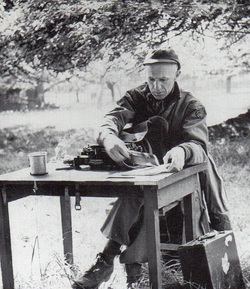 Photo from Ernie Pyle's War by James Tobin Photo from Ernie Pyle's War by James Tobin As I’ve gone through the process of researching what life was like for a military man or woman who had their boots on the ground or their oars in the water in WW2, I’ve become so fascinated with the day to day reportings of the war correspondents who were there alongside of these folks in and out of battle situations. Writers I’ve profiled such as Duncan Norton-Taylor, James Horan and photographers like Allan Jackson had such courage – courage that I’m not sure I could muster to do the job they had to do. They wrote about what they saw in only abstract terms, as reporting what they actually saw and experienced may have been too horrific for the American public to stomach. In some case the censors had the last say on whether or not something actually went to print. Imagine for a moment, you are basically a vagabond in a war zone. You have the clothes on your back and maybe a spare set or two in your pack, a bed roll, maybe a bottle of whiskey for fortification when needed along with necessary toiletries and any personal items you decide to pack. Add to that the weight of a portable typewriter that can weigh from 11-22 pounds and the paper and supplies you need to keep that piece of valuable equipment operating, sometimes in harsh weather or under fire near the battle front. That Royal is dead weight and can get heavy, but a correspondent doesn’t travel without one. To get around, they hitched rides in official vehicles, jeeps, PT boats, destroyers, carriers, Higgins boats, planes – anyhow and any way to get from one set of action to the other in order to do their job of telling the citizens back home about the life of the men and women on the front lines defending us against the Japanese and the Germans. One name kept jumping out at me and I decided to read about this unassuming and simple man who brought so much to the American people back home reading newspapers and magazines to get their information. I’d like to introduce you to Ernie Pyle. Ernie was born in Dana, Indiana on August 3rd, 1900. He was a farm boy who wanted nothing more than to get away from a life of digging dirt and caring for farm animals. A small boy grew into a man small in physical stature, but tall in terms of ambitions and the desire to see and write about the world. To that end, he ended up working for Scripps-Howard and was with them until his untimely death in 1945. Ernie was ever the vagabond, never kept his boots in one place for long. Working a desk at an inside job depressed and suppressed him, so he set out with his wife on the road to become a roving reporter. At first it was a Model-T, later in life they moved up to a Dodge convertible packed with everything they needed for life on the road. Home was the cheap hotel in the next town or the home of a friend they met as they happened to pass through a familiar town. His daily columns were written and transmitted verbally over the phone to a person taking shorthand on the other end. This was their lifestyle for years before he decided to set up a home in Albuquerque, New Mexico. Even with a home base there, the wanderer in him crept into every aspect of his life. He got the opportunity to satisfy this lust by traveling to Europe at the beginning of WW2 to cover the actions of the ground troops. Never one to just sit on the sidelines and get news second-hand, Ernies’s hallmark was the fact that he was with the advancing troops as they hit the shore, or on deck as the ship was being fired upon. His sympathies grew for the men who trundled through dirt, mud, bombed out cities and rubble, bodies on the ground of friend and enemy alike. He got to know them, reported about them by name and home town in his articles. As his travels progressed, his columns back home were picked up by more and more news agencies and he became a household name to the people who had sons, brothers, sisters, uncles and aunts serving in all aspects of the war. He spent the majority of his time during the war, about 2.5 years over in the European and African theater. In 1944 he returned home to New Mexico for a break, as the stresses of things he was seeing and experiencing began to take its toll on his well-being. Soon though, he began to feel he needed to expand his coverage to the war in the south Pacific. Ernie made the fateful decision to head west and cover the Naval operations and ground troops fighting in the Pacific. It was here on the island of Ie Shima on April 18th, 1945 that a snipers bullet met his left temple just below his metal helmet. The most lauded and loved war correspondent of WW2, the common man who kept all of America enthralled with his folksy, honest and heart-felt reporting of the war lost his life in the line of duty. He helped people understand the life and death brought on by wars that are bigger than any one man or woman alone, any one country alone. The following excerpt gives you an idea of his mission as he saw it. About the upcoming victory in Europe he wrote: “…in the joyousness of high spirits it is easy for us to forget the dead….there are so many of the living who have burned into their brains forever the unnatural sight of cold dead men scattered over the hillsides and in the ditches along the high rows of hedge throughout the world. Dead men by mass production – in one country after another – month after month and year after year. Dead men in winter and dead men in summer. Dead men in such familiar promiscuity that they become monotonous. Dead men in such monstrous infinity that you come almost to hate them. Those are the things that you at home need not even try to understand. To you at home they are columns of figures, or he is a near one who went away and just didn’t come back. You didn’t see him lying so grotesque and pasty beside the gravel road in France. We saw him. Saw him by the multiple thousands. That’s the difference.” Our correspondents today travel with camera crews. They transmit stories live via satellite, over broadband using cell phones or iPads. Most still put themselves in the way of danger to tell the stories that we should pay more attention to. Ernie Pyle’s observations remind us why we should never take for granted the life or death of any person we send to war in service to their country. It’s not really so far away, wherever the action takes place. It’s a smaller world than it used to be because of modern methods of communication and getting news out. We need to keep that in mind as much now, if not more. Thank you Ernie for leading the way to personalizing these stories for the people. You have not been forgotten. -Tammi P.S. Thank you Jeb Fulham for reminding me of Ernie's most important piece on the death of Captain Waskow: http://journalism.indiana.edu/resources/erniepyle/wartime-columns/the-death-of-captain-waskow/
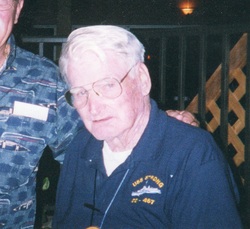 At 2003 STRONG Association reunion. At 2003 STRONG Association reunion. Regretfully, we have lost another STRONG DD 467 sailor. The family of St. Julien Barnwell, Seaman 1st class informed me of his passing yesterday. He died December 4th at age 92 in Charleston, South Carolina. This is the note I received from his nephew, Bob Harper: “My uncle, St. Julien "Doon" Mazyck Barnwell, seaman 1st class, died today in Charleston, SC. He was 92. All his life he spoke of his love for his shipmates on the Strong. Even after serving on the Tingey DD-539, getting wounded when all his buddies in the 40mm Bofors gun tub were killed by a Jap shell, he still spoke of his Strong shipmates. A very simple, humble man who would take the new clothes my mother gave him and give them to his buddies. He asked for nothing and took nothing living very quietly with never a cross word. He drove a truck for over 3 million miles free of any accidents or citations. He's gone to the final muster with his shipmates, the rest of the heroes of the USS Strong DD-467. Please update. He is survived by his daughters Diane (Moffett), who took him in 40 yrs ago, and Sheran (Caddell), and Charlie, his son along with my mother, his younger sister, Amelia "Toots" Barnwell Harper, who lives in Manning, SC. You can see their childhood home online by Googling "The Ruins" in Stateburg, SC-- a massive 200+ year old home. Best regards, Bob Harper” It was a couple of years ago that I first had contact with the Barnwell family. From that contact with his daughters Diane and Sheran, the family shared copies of letters he wrote home both before and after the sinking, letters written to his mother by the sister of Benjamin Frazier Jetton and the mother of Robert Gregory. Jetton was the senior officer to my great-uncle Billy and the two of them died together at their duty station. Gregory was one of the men to discover the body of 2nd Officer Fred Purdy. They helped with the identification by discovering Purdy's wallet on the body and turning it over to the authorities once they were rescued. There were many personal connections like this that were made between the families when they didn't have any idea of the fate of their sons, brothers, husbands and fathers in the time after STRONG was lost. Reaching out to the Barnwell family, these other families hoped to hear some word, some memory of the man they feared lost. Jetton was a casualty, but Gregory did make it home to his family. I feel privileged that the family shared these and other documents so I could learn about the person that was St. Julien. And, I am honored that in their time of loss they chose to inform me, and I feel it's my duty to let the other families know as well. Below you will find a link to the obituary on line, and contact information for Sheran Caddell is on the STRONG Contacts page. If you would like to send a personal condolence to the family, contact me for mailing addresses or other emails. To St. Julien Barnwell, S1c of the USS STRONG DD 467, we bid you farewell sir, and calm seas. -Tammi Link to obituary: http://www.legacy.com/obituaries/charleston/obituary.aspx?n=st-julien-mazyck-barnwell&pid=173371031&fhid=5500 |
Tammi JohnsonWelcome to the blog! I'm a life long Kentuckian with a degree in Anthropology, thus a nice background in research, thanks to some great profs at the University of Kentucky. Family and historical research are what float my boat, and this project has been the heart of it for a very long time now. I welcome input and ideas for blog entries, so if you have something to contribute I'll happily post it. Archives
March 2025
|